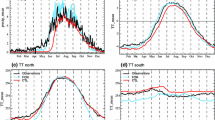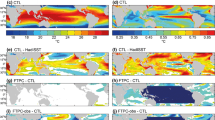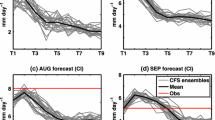Abstract
In this study, the impact of the ocean–atmosphere coupling on the atmospheric mean state over the Indian Ocean and the Indian Summer Monsoon (ISM) is examined in the framework of the SINTEX-F2 coupled model through forced and coupled control simulations and several sensitivity coupled experiments. During boreal winter and spring, most of the Indian Ocean biases are common in forced and coupled simulations, suggesting that the errors originate from the atmospheric model, especially a dry islands bias in the Maritime Continent. During boreal summer, the air-sea coupling decreases the ISM rainfall over South India and the monsoon strength to realistic amplitude, but at the expense of important degradations of the rainfall and Sea Surface Temperature (SST) mean states in the Indian Ocean. Strong SST biases of opposite sign are observed over the western (WIO) and eastern (EIO) tropical Indian Ocean. Rainfall amounts over the ocean (land) are systematically higher (lower) in the northern hemisphere and the south equatorial Indian Ocean rainfall band is missing in the control coupled simulation. During boreal fall, positive dipole-like errors emerge in the mean state of the coupled model, with warm and wet (cold and dry) biases in the WIO (EIO), suggesting again a significant impact of the SST errors. The exact contributions and the distinct roles of these SST errors in the seasonal mean atmospheric state of the coupled model have been further assessed with two sensitivity coupled experiments, in which the SST biases are replaced by observed climatology either in the WIO (warm bias) or EIO (cold bias). The correction of the WIO warm bias leads to a global decrease of rainfall in the monsoon region, which confirms that the WIO is an important source of moisture for the ISM. On the other hand, the correction of the EIO cold bias leads to a global improvement of precipitation and circulation mean state during summer and fall. Nevertheless, all these improvements due to SST corrections seem drastically limited by the atmosphere intrinsic biases, including prominently the unimodal oceanic position of the ITCZ (Inter Tropical Convergence Zone) during summer and the enhanced westward wind stress along the equator during fall.











Similar content being viewed by others
References
Dee DP et al (2011) The ERA-interim reanalysis: configuration and performance of the data assimilation system. Q J R Meteorol Soc 137:656, 553–597, Part A
Alessandri A, Gualdi S, Polcher J, Navarra A (2007) Effects of land surface–vegetation on the boreal summer surface climate of a GCM. J Clim 20:255–278. doi:10.1175/JCLI3983.1
Annamalai H (2010) Moist dynamical linkage between the Equatorial Indian Ocean and the South Asian monsoon trough. J Atmos Sci 67(3):589–610
Annamalai H, Murtugudde R (2004) Role of the Indian Ocean in regional climate variability. In: Wang C, Xie S-P, Carton JA (eds) Earth climate: the ocean-atmosphere interaction, vol 147. AGU Geophysical Monograph, Washington, DC, pp 213–246
Annamalai H, Liu P, Xie S-P (2005) Southwest Indian Ocean SST variability: its local effect and remote influence on Asian monsoons. J Clim 18:4150–4167
Annamalai H, Hamilton K, Sperber KR (2007) The South Asian summer monsoon and its relationship with ENSO in the IPCC AR4 simulations. J Clim 20:1071–1092. doi:10.1175/JCLI4035.1
Bollasina MA, Ming Y (2012) The general circulation model precipitation bias over the southwestern equatorial Indian Ocean and its implications for simulating the South Asian monsoon. Clim Dyn Online. doi:10.1007/s00382-012-1347-7
Bollasina MA, Nigam S (2009) Indian Ocean SST, evaporation, and precipitation during the South Asian summer monsoon in IPCCAR4 coupled simulations. Clim Dyn 33:1017–1032. doi:10.1007/s00382-008-0477-4
Boschat G, Terray P, Masson S (2011) Interannual relationships between Indian summer monsoon and Indo-Pacific coupled modes of variability during recent decades. Clim Dyn 37:1019–1043. doi:10.1007/s00382-010-0887-y
Boschat G, Terray P, Masson S (2012) Robustness of SST teleconnections and precursory patterns associated with the Indian summer monsoon. Clim Dyn 38:2143–2165. doi:10.1007/s00382-011-1100-7
Carton JA, Giese BS (2008) A reanalysis of ocean climate using simple ocean data assimilation (SODA). Mon Weather Rev 136:2999–3017
Chang C-P et al (2006) Climate fluctuations of tropical coupled systems—the role of ocean dynamics. J Clim 19:5122–5174
Cherchi A, Navarra A (2007) Sensitivity of the Asian summer monsoon to the horizontal resolution: differences between AMIP-type and coupled model experiments. Clim Dyn 28:273–290. doi:10.1007/s00382-006-0183-z
Chung CE, Ramanathan V (2006) Weakening of North Indian SST gradients and the monsoon rainfall in India and the Sahel. J Clim 19:2036–2045. doi:10.1175/JCLI3820.1
Compo GP, Whitaker JS, Sardeshmukh PD (2006) Feasibility of a 100-year reanalysis using only surface pressure data. Bull Am Meteorol Soc 87:175–190. doi:10.1175/BAMS-87-2-175
Drbohlav H-KL, Gualdi S, Navarra A (2007) A diagnostic study of the Indian Ocean Dipole mode in El Niño and Non–El Niño years. J Clim 20:2961–2977. doi:10.1175/JCLI4153.1
Fischer A, Terray P, Guilyardi E, Delecluse P (2005) Two independent triggers for the Indian Ocean Dipole/zonal mode in a coupled GCM. J Clim 18:3428–3449
Gill AE (1980) Some simple solutions for heat-induced tropical circulation. Q J R Meteorol Soc 106(449):447–462. doi:10.1002/qj.49710644905
Gimeno L, Drumond A, Nieto R, Trigo RM, Stohl A (2010) On the origin of continental precipitation. Geophys Res Lett 37(13):1–7. doi:10.1029/2010GL043712
Gualdi S, Guilyardi E, Navarra A, Masina S, Delecluse P (2003a) The interannual variability in the tropical Indian Ocean as simulated by a CGCM. Clim Dyn 20:567–582
Gualdi S, Navarra A, Guilyardi E, Delecluse P (2003b) Assessment of the tropical Indo-Pacific climate in the SINTEX CGCM. Ann Geophys 46:1–26
Guilyardi E, Delecluse P, Gualdi S, Navarra A (2003) Mechanisms for ENSO phase change in a coupled GCM. J Clim 16:1141–1158
Huffman GJ et al (1997) The global precipitation climatology project (GPCP) combined precipitation dataset. Bull Am Meteorol Soc 78:5–20
Izumo T, Montégut CB, Luo J–J, Behera SK, Masson S, Yamagata T (2008) The role of the western Arabian Sea upwelling in Indian monsoon rainfall variability. J Clim 21:5603–5623. doi:10.1175/2008JCLI2158.1
Izumo T, Vialard J, Lengaigne M, De Boyer Montegut C, Behera SK, Luo J–J, Cravatte S, Masson S, Yamagata T (2010) Influence of the state of the Indian Ocean Dipole on the following year’s El Niño. Nat Geosci 3(3):168–172
Joseph P, Eischeid JK, Pyle RJ (1994) Interannual variability of the onset of the Indian summer monsoon and its association with atmospheric features, El Niño, and sea surface temperature anomalies. J Clim 7:81–105
Joseph PV, Sooraj KP, Rajan CK (2003) Conditions leading to monsoon onset over Kerala and the associated Hadley cell. Mausam 54(1):155–164
Joseph S, Sahai AK, Goswami BN, Terray P, Masson S, Luo J–J (2012) Possible role of warm SST bias in the simulation of boreal summer monsoon in SINTEX-F2 coupled model. Clim Dyn 38:1561–1576. doi:10.1007/s00382-011-1264-1
Koch-Larrouy A, Madec G, Bouruet-Aubertot P, Gerkema T, Bessières L, Molcard R (2007) On the transformation of Pacific Water into Indonesian throughflow water by internal tidal mixing. Geophys Res Lett 34:L04604. doi:10.1029/2006GL028405
Kripalani RH, Oh JH, Kulkarni A, Sabade SS, Chaudhari HS (2007) South Asian summer monsoon precipitation variability: coupled climate model simulations and projections under IPCC AR4. Theor Appl Climatol 90:133–159. doi:10.1007/s00704-006-0282-0
Krishnan R, Zhang C, Sugi M (2000) Dynamics of breaks in the Indian summer monsoon. J Atmos Sci 1969:1354–1372
Kumar KK, Hoerling M, Rajagopalan B (2005) Advancing dynamical predictions of the Indian monsoon rainfall. Geophys Res Lett 32:L08704. doi:10.1029/2004GL021979
Kummerow C et al (2001) The evolution of the goddard profiling algorithm (GPROF) for rainfall estimation from passive microwave sensors. J Appl Meteorol 40:1801–1820
Levine RC, Turner AG (2012) Dependence of Indian Monsoon rainfall on moisture fluxes across the Arabian Sea and the impact of coupled model sea surface temperature biases. Clim Dyn 38:2167–2190. doi:10.1007/s00382-011-1096-z
Li T, Wang B, Chang C-P, Zhang Y (2003) A theory for the Indian Ocean Dipole–zonal mode. J Atmos Sci 60:2119–2135
Lin J-L (2007) The double-ITCZ problem in IPCC AR4 coupled GCMs: ocean–atmosphere feedback analysis. J Clim 20:4497–4525
Loschnigg J, Meehl G, Webster P, Arblaster J, Compo G (2003) The Asian Monsoon, the tropical biennial oscillation, and the Indian Ocean zonal mode in the NCAR CSM. J Clim 16:1617–1642
Luo J–J, Masson S, Behera SK, Delecluse P, Gualdi S, Navarra A, Yamagata T (2003) South Pacific origin of the decadal ENSO-like variation as simulated by a coupled GCM. Geophys Res Lett 30:2250. doi:10.1029/2003GL018649
Luo JJ, Masson S, Behera SK, Shingu S, Yamagata T (2005) Seasonal climate predictability in a coupled OAGCM using a different approach for ensemble forecasts. J Clim 18:4474–4497. doi:10.1175/JCLI3526.1
Luo J–J, Zhang R, Behera SK, Masumoto Y, Jin FF, Lukas R, Yamagata T (2010) Interaction between El Niño and Extreme Indian Ocean dipole. J Clim 23:726–742
Madec G (2008) NEMO ocean engine. Note du Pôle de modélisation, Institut Pierre-Simon Laplace (IPSL), France. No 27. ISSN No 1288-1619
Madec G, Delecluse P, Imbard M, Levy C (1998) OPA 8.1 ocean general circulation model reference manual. Note du Pôle de modélisation, Institut Pierre-Simon Laplace (IPSL), France. No 11, 91 pp. Available at http://www.lodyc.jussieu.fr/NEMO/general/manual/Doc_OPA8.1.pdf
Masson S, Luo JJ, Madec G, Vialard J, Durand F, Gualdi S, Guilyardi E, Behera S, Delecluse P, et al (2005) Impact of barrier layer on winter-spring variability of the southeastern Arabian Sea. Geophys Res Lett 32: L07703, 1–4
Masson S, Terray P, Madec G, Luo J–J, Yamagata T, Takahashi K (2012) Impact of intra-daily SST variability on ENSO characteristics in a coupled model. Clim Dyn 39:681–707. doi:10.1007/s00382-011-1247-2
Neale R, Slingo J (2003) The maritime continent and its role in the global climate: a GCM study. J Clim 16:834–848
Nordeng TE (1994) Extended versions of the convective parameterization scheme at ECMWF and their impact on the mean and transient activity of the model in the tropics. ECMWF Research Dept. Tech. Memo. 206, European Centre for Medium-Range Weather Forecasts, Reading, United Kingdom, 41 pp
Reynolds RW, Smith TM, Liu C, Chelton DB, Casey KS, Schlax MG (2007) Daily high-resolution blended analyses for sea surface temperature. J Clim 20:5473–5496
Roeckner E, Alfred S, Amala Y (1996) The atmospheric general circulation model ECHAM-4: model description and simulation of present-day climate. Max-Planck-Institut für Meteorologie. Report no. 218, 94 pp, Hamburg
Roeckner E, Baüml G, Bonaventura L, Brokopf R, Esch M, Giorgetta M, Hagemann S et al (2003) The atmospheric general circulation model ECHAM5: Part 1: model description. Max-Planck-Institut für Meteorologie, MPI-Report 353, Hamburg
Roeckner E, Brokopf R, Esch M, Giorgetta M, Hagemann S, Kornblueh L, Manzini E, Schlese U, Schulzweida U (2004) The atmospheric general circulation model ECHAM5 Part II: sensitivity of simulated climate to horizontal and vertical resolution. Max-Planck-Institute for Meteorology, MPI-Report 354, Hamburg
Schott FA, McCreary JP Jr (2001) The monsoon circulation of the Indian Ocean. Prog Oceanogr 51:1–123
Schott F, Fischer J, Garternicht U, Quadfasel D (1997) Summer monsoon response of the northern Somali Current, 1995. Geophys Res Lett 24:2565–2568
Shukla J, Hagedorn R, Hoskins B, Kinter J, Marotzke J, Miller M, Palmer TN, Slingo J (2009) Revolution in climate prediction is both necessary and possible: a declaration at the world modelling summit for climate prediction. Bull Am Meteorol Soc 90:175–178
Sijikumar S, Rajeev K (2012) Role of the Arabian Sea Warm Pool on the precipitation characteristics during the monsoon onset period. J Clim 25:1890–1899. doi:10.1175/JCLI-D-11-00286.1
Soman MK, Slingo JM (1997) Sensitivity of the Asian summer monsoon to aspects of sea-surface-temperature anomalies in the tropical Pacific. Q J R Meteorol Soc 123:309–336
Spencer H, Sutton RT, Slingo JM, Roberts JM, Black E (2005) The Indian Ocean climate and dipole variability in the Hadley centre coupled GCMs. J Clim 18:2286–2307
Terray P, Guilyardi E, Fischer AS, Delecluse P (2005) Dynamics of the Indian Monsoon and ENSO relationships in the SINTEX global coupled model. Clim Dyn 24:145–168
Terray P, Chauvin F, Douville H (2007) Impact of southeast Indian Ocean sea surface temperature anomalies on monsoon-ENSO- dipole variability in a coupled ocean-atmosphere model. Clim Dyn 28:553–580. doi:10.1007/s00382-006-0192-y
Terray P, Kamala K, Masson S, Madec G, Sahai AK, Luo J–J, Yamagata T (2012) The role of the intra-daily SST variability in the Indian Monsoon variability and monsoon-ENSO–IOD relationships in a global coupled model. Clim Dyn 39:729–754. doi:10.1007/s00382-011-1240-9
Tiedtke M (1989) A comprehensive mass flux scheme for cumulus parameterization in large-scale models. Mon Weather Rev 117:1779–1800
Timmermann R, Goosse H, Madec G, Fichefet T, Ethe C, Duliere V (2005) On the representation of high latitude processes in the ORCA-LIM global coupled sea ice-ocean model. Ocean Model 8(1–2):175–201
Valcke S (2006) OASIS3 user guide (prism_2-5). PRISM support initiative report No 3, 64 pp
Wang B (2006) The Asian Monsoon. Springer/Praxis Publishing, New York, p 787
Wang B, Wu R, Lau KM (2001) Interannual variability of the Asian summer monsoon: contrast between the Indian and the Western North Pacific–East Asian monsoons. J Clim 14:4073–4090
Wang B, Kang I, Lee J (2004) Ensemble simulations of Asian–Australian monsoon variability by 11 AGCMs. J Clim 17:803–818
Wang B, Ding QH, Fu XH, Kang I-S, Jin K, Shukla J, Doblas-Reyes F (2005) Fundamental challenge in simulation and prediction of summer monsoon rainfall. Geophysl Res Lett 32:L15711
Wang B, Lee JY, Kang IS, Shukla J, Kug JS, Kumar A, Schemm J, Luo JJ, Yamagata T, Park CK (2008) How accurately do coupled climate models predict the leading modes of Asian-Australian monsoon interannual variability? Clim Dyn 30:605–619. doi:10.1007/s00382-007-0310-5
Wentz FJ, Gentemann C, Smith D, Chelton D (2000) Satellite measurements of sea surface temperature through clouds. Science 288:847
Wu RG, Kirtman BP (2005) Roles of Indian and Pacific Ocean air-sea coupling in tropical atmospheric variability. Clim Dyn 25:155–170
Xavier PK, Marzin C, Goswami BN (2007) An objective definition of the Indian summer monsoon season and a new perspective on the ENSO-Monsoon relationship. Q J R Meteorol Soc 133:749–764
Yokoi T, Tozuka T, Yamagata T (2008) Seasonal variation of the Seychelles Dome. J Clim 21:3740–3754. doi:10.1175/2008JCLI1957.1
Acknowledgments
A part of this research was supported by the Japan Science and Technology Agency/Japan International Cooperation Agency through the Science and Technology Research Partnership for Sustainable Development (SATREPS). This work was performed using HPC resources from GENCI-IDRIS (Grant 2012-x2012016895).
Author information
Authors and Affiliations
Corresponding author
Rights and permissions
About this article
Cite this article
Prodhomme, C., Terray, P., Masson, S. et al. Impacts of Indian Ocean SST biases on the Indian Monsoon: as simulated in a global coupled model. Clim Dyn 42, 271–290 (2014). https://doi.org/10.1007/s00382-013-1671-6
Received:
Accepted:
Published:
Issue Date:
DOI: https://doi.org/10.1007/s00382-013-1671-6




